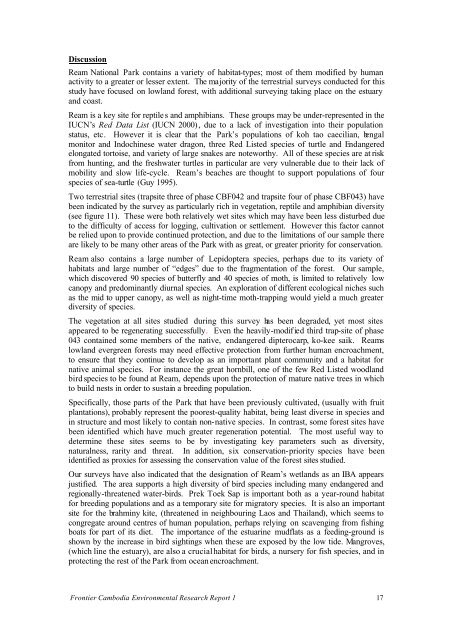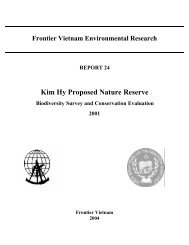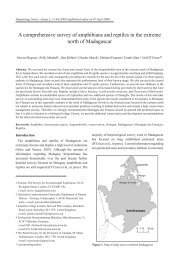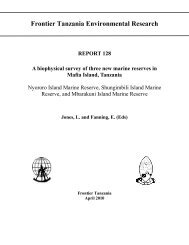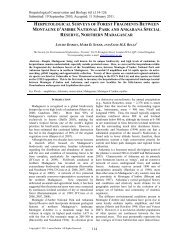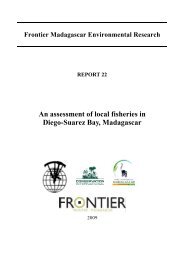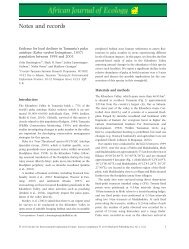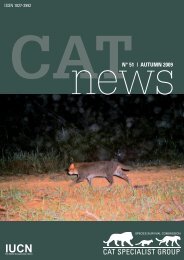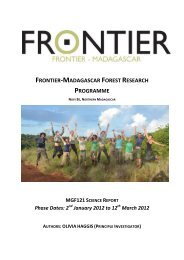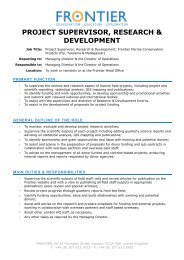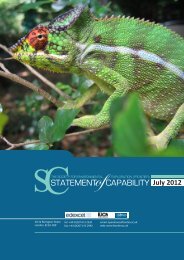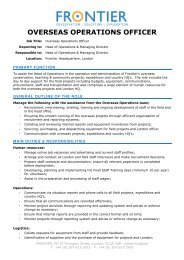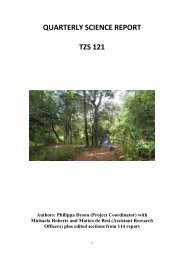Ream National Park Twelve Month Report
Ream National Park Twelve Month Report
Ream National Park Twelve Month Report
You also want an ePaper? Increase the reach of your titles
YUMPU automatically turns print PDFs into web optimized ePapers that Google loves.
Discussion<br />
<strong>Ream</strong> <strong>National</strong> <strong>Park</strong> contains a variety of habitat-types; most of them modified by human<br />
activity to a greater or lesser extent. The majority of the terrestrial surveys conducted for this<br />
study have focused on lowland forest, with additional surveying taking place on the estuary<br />
and coast.<br />
<strong>Ream</strong> is a key site for reptile s and amphibians. These groups may be under-represented in the<br />
IUCN’s Red Data List (IUCN 2000), due to a lack of investigation into their population<br />
status, etc. However it is clear that the <strong>Park</strong>’s populations of koh tao caecilian, bengal<br />
monitor and Indochinese water dragon, three Red Listed species of turtle and Endangered<br />
elongated tortoise, and variety of large snakes are noteworthy. All of these species are at risk<br />
from hunting, and the freshwater turtles in particular are very vulnerable due to their lack of<br />
mobility and slow life-cycle. <strong>Ream</strong>’s beaches are thought to support populations of four<br />
species of sea-turtle (Guy 1995).<br />
Two terrestrial sites (trapsite three of phase CBF042 and trapsite four of phase CBF043) have<br />
been indicated by the survey as particularly rich in vegetation, reptile and amphibian diversity<br />
(see figure 11). These were both relatively wet sites which may have been less disturbed due<br />
to the difficulty of access for logging, cultivation or settlement. However this factor cannot<br />
be relied upon to provide continued protection, and due to the limitations of our sample there<br />
are likely to be many other areas of the <strong>Park</strong> with as great, or greater priority for conservation.<br />
<strong>Ream</strong> also contains a large number of Lepidoptera species, perhaps due to its variety of<br />
habitats and large number of “edges” due to the fragmentation of the forest. Our sample,<br />
which discovered 90 species of butterfly and 40 species of moth, is limited to relatively low<br />
canopy and predominantly diurnal species. An exploration of different ecological niches such<br />
as the mid to upper canopy, as well as night-time moth-trapping would yield a much greater<br />
diversity of species.<br />
The vegetation at all sites studied during this survey has been degraded, yet most sites<br />
appeared to be regenerating successfully. Even the heavily-modified third trap-site of phase<br />
043 contained some members of the native, endangered dipterocarp, ko-kee saik. <strong>Ream</strong>s<br />
lowland evergreen forests may need effective protection from further human encroachment,<br />
to ensure that they continue to develop as an important plant community and a habitat for<br />
native animal species. For instance the great hornbill, one of the few Red Listed woodland<br />
bird species to be found at <strong>Ream</strong>, depends upon the protection of mature native trees in which<br />
to build nests in order to sustain a breeding population.<br />
Specifically, those parts of the <strong>Park</strong> that have been previously cultivated, (usually with fruit<br />
plantations), probably represent the poorest-quality habitat, being least diverse in species and<br />
in structure and most likely to contain non-native species. In contrast, some forest sites have<br />
been identified which have much greater regeneration potential. The most useful way to<br />
determine these sites seems to be by investigating key parameters such as diversity,<br />
naturalness, rarity and threat. In addition, six conservation-priority species have been<br />
identified as proxies for assessing the conservation value of the forest sites studied.<br />
Our surveys have also indicated that the designation of <strong>Ream</strong>’s wetlands as an IBA appears<br />
justified. The area supports a high diversity of bird species including many endangered and<br />
regionally-threatened water-birds. Prek Toek Sap is important both as a year-round habitat<br />
for breeding populations and as a temporary site for migratory species. It is also an important<br />
site for the brahminy kite, (threatened in neighbouring Laos and Thailand), which seems to<br />
congregate around centres of human population, perhaps relying on scavenging from fishing<br />
boats for part of its diet. The importance of the estuarine mudflats as a feeding-ground is<br />
shown by the increase in bird sightings when these are exposed by the low tide. Mangroves,<br />
(which line the estuary), are also a crucial habitat for birds, a nursery for fish species, and in<br />
protecting the rest of the <strong>Park</strong> from ocean encroachment.<br />
Frontier Cambodia Environmental Research <strong>Report</strong> 1<br />
17


